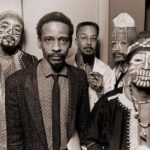Ears Embiggened: Icons

(The fifth in a series of preview posts as we count down to the
2019 Big Ears Festival in Knoxville, TN.
Part 1 here on the 50 year legacy of ECM Records.
Part 2 here on 50 years of the Art Ensemble of Chicago,
Great Black Music: Ancient to the Future.
Part 3 here on the magnificent Rhiannon Giddens and her Lucy Negro, Redux project.
Part 4 takes a stroll through the league of guitarists on tap.)
We often hear an artist described as an overnight sensation, even though in almost every case we are hearing about someone who has put in the work and paid the dues to arrive at their ‘instant’ success.
But you never really hear about an overnight icon. Defined as “a person or thing regarded as a representative symbol or as worthy of veneration,” icon status is almost always predicated on longevity, extended and sustained effort, and definitional achievement in a field of endeavor.
Big Ears has a pretty good track record of lining up artists that qualify for icon status. 2019 is no exception. I’ve already written about some of these: Art Ensemble of Chicago, Bill Frisell, ECM Records, Richard Thompson. Time to take a look at the rest.
Carla Bley
Carla Bley stands about five feet tall, yet she is a undeniable giant. Stretching back nearly 60 years, Carla’s compositions have been recorded by Jimmy Giuffre, George Russell, her ex-husband Paul Bley, Gary Burton, Charlie Haden, and many more. Along with her second husband, trumpeter Michael Mantler, she founded the Jazz Composer’s Orchestra and the associated JCOA record label, which released important recordings by Don Cherry, Roswell Rudd, Grachan Moncur, Leroy Jenkins, and Cecil Taylor in the late 60s.
In 1971, JCOA released her epic jazz opera Escalator Over the Hill. It took three years to record, and established Bley as one of the great composer/arrangers in modern jazz. During the 70s, she collaborated with Jack Bruce and drummer Nick Mason of Pink Floyd, essentially writing and arranging albums released under their names. She also helped Charlie Haden actualize his great Liberation Music Orchestra.
Better known for most of her career for her composing/arranging, in the past twenty years she has developed into one of the most intriguing pianists in jazz. She’s not a chops monster by any stretch, but her arranger’s orientation has led her into a crazy wonderful ability to instigate quiet upheaval with peculiar chord voicings and melodic coloration. Her playing is probably closer to fellow arranger genius Gil Evans than anybody else, that uncanny knack for bending a chord in a way that makes you wonder if the ground has shifted beneath you.
This year she returns to Big Ears with a trio formed in 1994, featuring bassist Steve Swallow, and saxophonist Andy Sheppard. They play with the kind of instinct and preternatural anticipation of one another’s choices that can only develop over a very long period of time. Saturday at 5 pm at the Tennessee Theater.
Getting to see her at Big Ears 2017, after 40 years of listening, was a dream come true. Also too: She also has the greatest hair in the history of the music.

Steve Swallow
Bassist and longtime musical and romantic partner of Carla Bley, Steve Swallow is the man who proved once and for all that the electric bass guitar is every bit as legitimate as the double bass in jazz. The man has all the tone and swing you could ask for. Since the early 60s, Swallow has worked with an almost ridiculous listing of the greats of the latter-20th century: Paul Bley, Jimmy Giuffre, Gary Burton, Don Ellis, Art Farmer, Stan Getz, Paul Motian, John Scofield, George Russell. His playing is elegant, smooth, and always exactly what the music needs. Appearing with the Carla Bley Trio.
Harold Budd
During the 60s, Budd was a composer of avant garde classical pieces. He began to become more interested in minimalism, an interest starkly at odds with academic composition of the day. By 1970, he says he had:
…minimalized myself out of a career. It had taken ten years to reduce my language to zero but I loved the process of seeing it occur and not knowing when the end would come. By then I had opted out of avant-garde music generally; it seemed self-congratulatory and risk-free and my solution as to what to do next was to do nothing, to stop completely.”
In 1978, he released his first major work, Pavilion of Dreams, on Brian Eno’s Ambient Music Series. Any serious history of ambient music recognizes Budd’s central role in the development of that genre, though Budd insists he was “hijacked” into the category.
Whatever. Labels never tell an accurate story. Suffice to say that his three presentations at this year’s festival offer a rare opportunity to experience one of the path-forging icons of the past 50 years. Must. See.
Meredith Monk
Back in the day of college radio, a cluster of us became obsessed with every box of promo records that came in from ECM. One day in 1981 we pulled one out that looked a little different. The abstract imagery typical of the ECM cover was replaced by a dramatic b&w photo of a woman in shadow, head cocked to allow a dark shadow from an epic hair braid to fall across her neck.
This was the beginning of my love affair with the music of Meredith Monk.
It was like nothing I had ever heard, though it was as instantly accessible as the most finely crafted pop tune. It was funny. It was deep and dark. It was impossible. Even in its darkest moments, it exuded pure joy. I was hooked.
She is a composer, film director, choreographer and one of the pioneers of extended vocal technique. She returns to Big Ears with her latest work, Celluar Songs, described as a blend of
movement, theatrical characters and images, light, and video installation. The work, at once playful and contemplative, draws inspiration from such cellular activity as layering, replication, division and mutation, and looks to underlying systems in nature that can serve as a prototype for human behavior in our tumultuous world. Conjuring cycles of birth and death throughout, Monk once again reminds us of her vitality as an artist who cuts to the core of experience, continuing to share the genius of her discovery and innovation.
I am so there.
Alvin Lucier
I have to admit: Before this year’s festival schedule dropped, Alvin Lucier was a vaguely recognized name for me. But dang, y’all, the man has delivered the deep sounds for more than fifty years. As much a ‘sound artist’ as a musician composer, Lucier’s work suggests a sensibility in line with Pauline Oliveros’ concept of Deep Listening.
One of his most recognized pieces, I Am Sitting in a Room, begins with the performer reciting and recording a paragraph of text that describes the piece. The recorded passage plays back in the room, recorded again, and played back again, and again, etc. A simple layering technique not unlike Fripp’s dual-Revox Frippertronics, but the only additive information is created by the resonance of the room itself, and the acoustic peculiarities of speakers and microphones recording the proceedings. Within a few minutes, the speech becomes nearly unrecognizable, with specific tones emphasized or muffled by the room resonance to create a strange push-pull effect. By the end, everything is a wash of enveloping sound.
During his early years, Lucier created several pieces of this nature; let’s call them mechanical processes in that an initial action sets off a chain of successive occurrences without performer intervention. He later moved onto composing for trained musicians, often accompanied by pure wave generator. The variances of the musician’s tones in reference to the pure wave creates washes of harmonic overtones that can take on the character of other instruments, celestial choirs, or skull-threatening dark vibration.
At 88 years of age, Lucier rarely performs, but he has three sets on tap at Big Ears, including one with his longtime collaborator Joan LaBarbara. Make a point of catching at least one.
Joan LaBarbara
Who is Joan LaBarbara, you asked quietly as you read the last paragraph.
LaBarbara was one of the second wave of extended vocal technique champions, heir to Cathy Berberian’s 1960s investigations and contemporaneous with Meredith Monk. Her debut album, Voice is the Original Instrument, is a psychedelic funhouse ride, most notably her use of circular breathing and multiphonics.
And if you – or your kids – are of a certain age, you might even know her work.
LaBarbara performs twice at Big Ears, once in a solo career retrospective and alongside Alvin Lucier and the Ever Present Orchestra in a program of Lucier’s work.
Jack DeJohnette
Along with Tony Williams and Famoudou Don Moye, Jack DeJohnette is one of the primary definers of the post-Elvin Jones/Max Roach approach to drumming.
The man deserves a book or five and a documentary or two. He is one of the instantly recognizable drummers in jazz. His sense of swing and his range of touch on the drums and, especially, the cymbals mark him within a few bars. He is also a fine pianist and composer. The man is, well, an icon.
At Big Ears, DeJohnette rolls in with a trio featuring Ravi Coltrane on sax and Matt Garrison on bass and electronics. Ravi’s dad? John Coltrane. Matt’s dad? Trane’s longtime bassist, Jimmy Garrison. An icon with the sons of two icons. Is it gonna be great? I’m skipping at least three performances I really ought to see for this one. Whaddyagonnado? Saturday, 7.45 pm, at the Tennessee Theatre.
Here’s one of my favorite DeJohnette tracks from his New Directions quartet.
Wadada Leo Smith
Wadada Leo Smith was born in Leland, Mississippi and recieved his first musical education in the Delta blues at his father’s knee. He went through the military band program and ended up in the middle of the 1960s Chicago scene, one of the early members of the Association for the Advancement for Creative Musicans. He is a prolific composer, an educator, and has always maintained his musical practice as a component of his social activist practice.
Here’s a partial list of Smith’s collaborations: Anthony Braxton, Leroy Jenkins, Roscoe Mitchell, Henry Threadgill, Lester Bowie, Joseph Jarman, Cecil Taylor, Steve McCall, Anthony Davis, Carla Bley, Don Cherry, Jeanne Lee, Tadao Sawai, Muhal Richard Abrams, Ed Blackwell, Kazuko Shiraishi, Han Bennink, Marion Brown, Charlie Haden, Malachi Favors Magoustous, Jack Dejohnette, Vijay Iyer, Ikue Mori, Min Xiao Fen, Bill Laswell, John Zorn, Ronald Shannon Jackson, Frank Lowe, Andrew Cyrille, and Bill Frisell.
He is equally at home in what we might call “classical” music as he is digging in with the funk-skronk of the band Harriet Tubman or his Yo, Miles collaborations with Henry Kaiser. He can blast you through your seat or make you float into someplace you never knew existed. His graphic scores, executed in a system he calls Ankhrasmation, are on display in museums.
I last saw Wadada live in 1980, at Papp’s Public Theatre. The amount of space between notes was at times nearly unbearable. But then, the right note, or smear or gesture, arrived to maintain a sense of structure that kept me from leaping from my seat in anxiety.
For Big Ears, Smith has two performances in store. His solo exploration, Reflections and Meditations on Monk, drops at The Standard on Saturday at 2 pm. But the big deal is the presentation of Smith’s 1978 masterpiece Divine Love, with original trio members Dwight Andrews and Bobby Naughton. That happens at the Tennessee Theatre on Sunday at 6.15 pm, a perfect lead in to the festival-capping performance by the Art Ensemble of Chicago.





